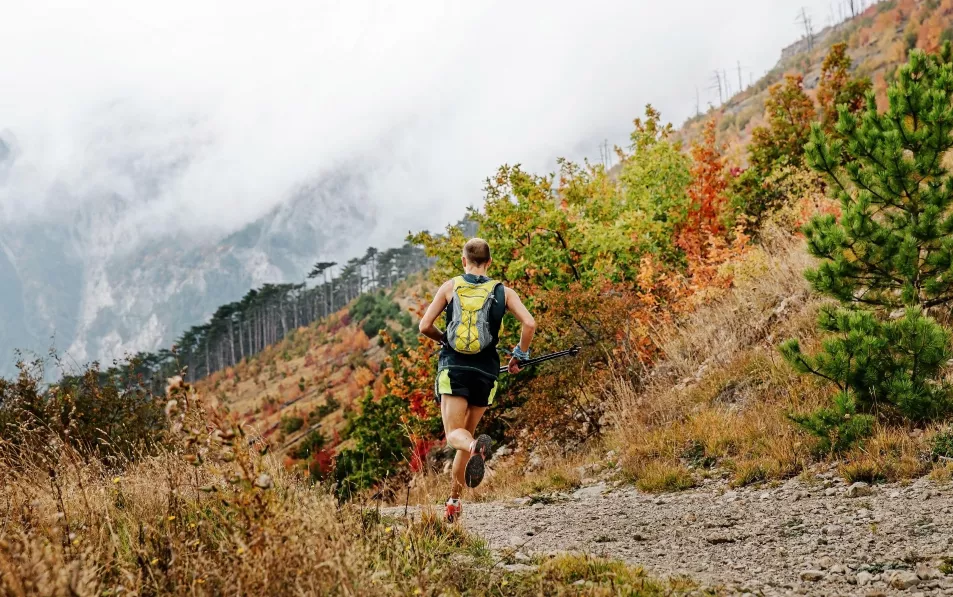With so much of the gorgeous countryside on our doorsteps, or a train ride away unexplored, we all are looking for new ways to get out and about.
Trail running could be the adventurous workout that helps us do just that, as it combines hillwalking, running and hiking, taking runners to remote corners of the planet, and travelling the world in their trainers.
With sports brands like Nike, Salomon and Vivobarefoot placing an increasing emphasis on their trail options for runners, and a gradual increase in Google searches for ‘trail running’ over the past five years, what actually is it?
View this post on Instagram
Advertisement
“Technically speaking, trail running is a form of running that takes place on varied terrains, away from paved paths or tracks,” says Jodie Gauld, run leader for Love Trails Festival. “However, it’s so much more, it’s a special feeling and a welcoming community.”
The benefits
“I find trail running very calming, and my focus will be very present. You’re typically in nature, so rather than modern distractions like cars, bustling streets and flashing signs, you can instead be in the moment of your running and in awe of your surroundings, which can give life a new perspective on what really matters,” Gauld reflects.
There is less focus on speed and more on experience.

“Trail running can also be very playful. It’s typically less serious, because the nature of running over varying terrains and up and down different gradients, means pacing and timing are less controllable or comparable,” she says.
“Then, even if you hit a path with a good rhythm, you still have to concentrate, because there could be obstacles. You can hit an ultimate high – your focus becomes super-zoned, while your pace is good and you feel like you’re flying.”
It’s easy to find community in trail running, because it’s an equaliser.
“Because trail running is less about pace, it’s really inclusive. Seriously, if you do a trail race, the first question won’t be about your time, it’ll be about your experience,” says Gauld. “These factors and so many more, mean that trail running attracts a wonderful, supportive community. I’ve run all my life and have been knowingly trail running for over a decade, and don’t think I’ve ever met another trail runner who hasn’t been encouraging and friendly.”
The required kit

“While road shoes will be fine on hard-packed trails, you’ll get even more fun with a pair of trail shoes. Trainers specifically designed for the trails will have grip for the varying terrains, and will save you slipping around,” Gauld continues.
When looking for the right shoes, Ben Le Vesconte, head coach at Vivobarefoot says “Look for wide toe boxes which allow your toes to spread, to ensure you remain balanced and stable on the trail.”
Next, he recommends looking for thin soles, so you can feel the trail underneath your feet. “It will help you feel the changing terrain, allowing you to react quickly and improve your stability. The more cushioning you add, the less you feel.
View this post on Instagram
“Think about the grip you choose, typically thicker and longer lugs [small points of raised rubber lining the outsole] are best for muddy terrain, with smaller lugs best for firmer terrain. If it’s wet weather or waterlogged terrain, you want a shoe that drains well and for the heat, it should be very breathable,” he explains.
Your kit is more important than it is for road running, because you’re likely to be away from access to help, and there are more things that can potentially go wrong.
“With this in mind, I typically take my running vest or a hydration pack, no matter how short the distance, in which I’ll pack my phone – for photos but also safety – water, snacks, a foil blanket, a basic first aid kit, a waterproof and possibly spare layers,” says Gauld. “I also have a GPX watch, mainly for the mapping tools, but this is expensive, and there are loads of accessible mapping apps on phones now.”
The risks
“In a lot of trail races, there will be a kit list – this will be for safety reasons and encourages respect in nature where the conditions can change very quickly. I started a race in nearly 30-degree heat, and within just a few hours, we were in hypothermic conditions and hail storms. I finished that race – while others more experienced than me dropped out – because I had all the kit,” Gauld reveals.
“Of course, like any activity, there are things to be wary of. When you’re starting, take your time and get used to the uneven and varied terrain,” says Matt Buck, a trail running coach, owner of Running Adventures and guide runner for Love Trails Festival.
“Make sure you take a friend, or at the least tell someone where you are going, and always have a phone on you in case you need to call for help. Take it slow, and you will be fine.”







